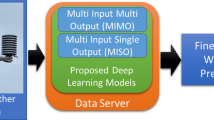Abstract
Ozone is a toxic gas with massive distinct chemical components from oxygen. Breathing ozone in the air can cause severe effects on human health, especially people who have asthma. It can cause long-lasting damage to the lungs and heart attacks and might lead to death. Forecasting the ozone concentration levels and related pollutant attribute is critical for developing sophisticated environment safety policies. In this paper, we present three artificial neural network (ANN) models to forecast the daily ozone (O3), coarse particulate matter (PM10), and particulate matter (PM2.5) concentrations in a highly polluted city in the Republic of China. The proposed models are (1) recurrent multilayer perceptron (RMLP), (2) recurrent fuzzy neural network (RFNN), and (3) hybridization of RFNN and grey wolf optimizer (GWO), which are referred to as RMLP-ANN, RFNN, and RFNN-GWO models, respectively. The performance of the proposed models is compared with other conventional models previously reported in the literature. The comparative results showed that the proposed models presented outstanding performance. The RFNN-GWO model revealed superior results in the modeling of O3, PM10, and PM2.5 compared with the RMLP-ANN and RFNN models.










Similar content being viewed by others
References
Ababneh M, Ala'a O, Btoush M (2014) PM10 forecasting using soft computing techniques. Res J Appl Sci Eng 7(16):3253–3265
Alkasassbeh M, Sheta A, Faris H, Turabieh H (2013) Prediction of PM10 and TSP air pollution parameters using artificial neural network autoregressive, external input models: a case study in salt, Jordan. Middle-East J Sci Res 14(7):999–1009
Cetin M, Onac AK, Sevik H, Sen B (2019) Temporal and regional change of some air pollution parameters in bursa. Air Qual Atmos Health 2(3):31–316
Chang S, Pai T, Ho H, Leu H, Shieh Y (2007) Evaluating Taiwan’s air quality variation trends using grey system theory. J Chin Inst Eng 30(2):361–367
Cobourn WG, Dolcine L, French M, Hubbard MC (2000) A comparison of nonlinear regression and neural network models for ground-level ozone forecasting. J Air Waste Manage Assoc 50(11):1999–2009
Comrie AC (1997) Comparing neural networks and regression models for ozone forecasting. J Air Waste Manage Assoc 47(6):653–663
Ebi KL, McGregor G (2008) Climate change, tropospheric ozone, and particulate matter, and health impacts. Environ Health Perspect 116(11):1449–1455
Kao E (2018) Air pollution is killing 1 million people and costing the Chinese economy 267 billion yuan a year. Research from CUHK shows, South China Morning Post 2
Kovač-Andrić E, Sheta A, Faris H, Gajdošik MŠ (2016) Forecasting ozone concentrations in the east of Croatia using nonparametric neural network models. J Earth Syst Sci 125(5):997–1006
Krishan M, Jha S, Das J, Singh A, Goyal MK, Sekar C (2019) Air quality modelling using long short-term memory (LSTM) over NCT-Delhi. Air Qual Atmos Health 12(8):899–908
Martin EP (2011) Comparative performance of different statistical models for predicting ground-level ozone (O3) and fine particulate matter (PM2.5) concentrations in Montréal. Dissertation, Concordia University)
Mirjalili S, Mirjalili SM, Lewis A (2014) Grey wolf optimizer. Adv Eng Softw 69:46–61
Nozari HA, Banadaki HD, Mokhtare M, Vahed SH (2012) Intelligent non-linear modelling of an industrial winding process using recurrent local linear neuro-fuzzy networks. J Zhejiang Univ Science C 13(6):403–412
Paschalidou AK, Karakitsios S, Kleanthous S, Kassomenos PA (2011) Forecasting hourly PM10 concentration in Cyprus through artificial neural networks and multiple regression models: implications to local environmental management. Environ Sci Pollut Res 18(2):316–327
Razavi-Far R, Davilu H, Palade V, Lucas C (2009) Model-based fault detection and isolation of a steam generator using neuro-fuzzy networks. Neurocomputing 72(13–15):2939–2951
Rohde R, Muller R (2015) Air pollution in China: Mapping of concentrations and sources. PLoS One 10(8):1–14
Sharma L, Vishal V, Singh T (2017) Predicting CO2 permeability of bituminous coal using statistical and adaptive neuro-fuzzy analysis. J Nat Gas Sci Eng 42:216–225
Sheta AF, Braik M, Al-Hiary H (2019) Modeling the Tennessee Eastman chemical process reactor using bioinspired feedforward neural network (BI-FF-NN). Int J Adv Manuf Technol 103(1–4):1359–1380
Sheta AF, Braik M, Öznergiz E, Ayesh A, Masud M (2013) Design and automation for manufacturing processes: an intelligent business modeling using adaptive neuro-fuzzy inference systems. Bus Intell Perform Manag:191–208
Sheta AF, Faris H (2015) Influence of nitrogen-di-oxide, temperature, and relative humidity on surface ozone modeling process using multigene symbolic regression genetic programming. Int J Adv Comput Sci Appl 6(6):270–275
Sheta AF, Faris H, Rodan A, Kovač-Andrić A-ZAM (2018) Cycle reservoir with regular jumps for forecasting ozone concentrations: two real cases from the east of Croatia. Air Qual Atmos Health 11(5):559–569
Vahlsing C, Smith KR (2012) Global review of national ambient air quality standards for PM10 and SO2 (24h). Air Qual Atmos Health 5(4):393–399
Ventura LM, de Oliveira PF, Soares LM, Luna AS, Gioda A (2019) Forecast of daily PM2.5 concentrations applying artificial neural networks and Holt-Winters models. Air Qual Atmos Health 12(3):317–325
Yeganeh B, Hewson MG, Clifford S, Tavassoli A, Knibbs LD, Morawska L (2018) Estimating the spatiotemporal variation of no 2 concentration using an adaptive neuro-fuzzy inference system. Environ Model Softw 100:222–235
Zounemat-Kermani M, Teshnehlab M (2008) Using adaptive neuro-fuzzy inference system for hydrological time series prediction. Appl Soft Comput 8(2):928–936
Author information
Authors and Affiliations
Corresponding author
Additional information
Publisher’s note
Springer Nature remains neutral with regard to jurisdictional claims in published maps and institutional affiliations.
Rights and permissions
About this article
Cite this article
Braik, M., Sheta, A. & Al-Hiary, H. Hybrid neural network models for forecasting ozone and particulate matter concentrations in the Republic of China. Air Qual Atmos Health 13, 839–851 (2020). https://doi.org/10.1007/s11869-020-00841-7
Received:
Accepted:
Published:
Issue Date:
DOI: https://doi.org/10.1007/s11869-020-00841-7




